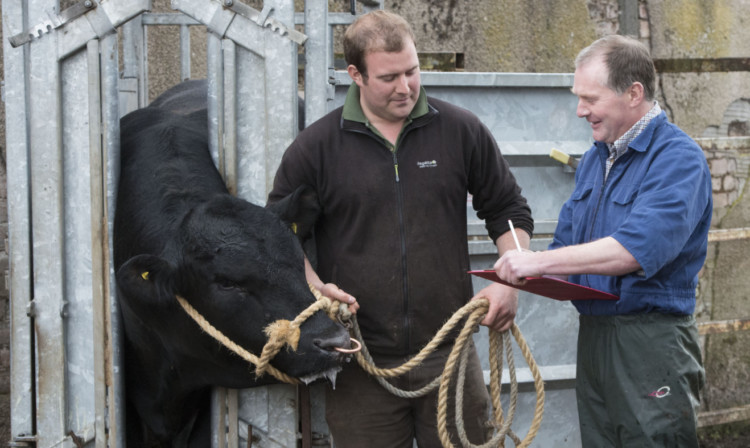As the spring calving period comes to an end on suckler farms throughout the country, farmers are being urged to think now about arranging a ‘bull MOT’ check to ensure cows get back in calf for next year.
Quality Meat Scotland’s Guide to Improving Suckler Herd Fertility reveals that in excess of one quarter of all working bulls can be sub-fertile or infertile.
By asking their vet to undertake an annual pre-breeding soundness check (PBS), problems can be identified in good time to prevent their bottom lines, and business efficiency, being hit as a result of cows not getting into calf.
Graeme Richardson, director and senior vet at Thrums Veterinary Group in Kirriemuir, has been carrying out PBS checks for more than 10 years and believes they are an important management tool to ensure a compact calving period and to improve herd efficiency.
Thrums Vets work in a 25-mile radius of the practice, and a large proportion of its beef farmer clients are now making use of the check-up.
“Our customers fall into three categories: those who have had a problem with a bull; those who carry out the checks routinely; and those who get new purchases checked.
“Unfortunately many farmers come to us because they have had a problem, but hopefully we can reduce the chances of the same thing happening again.”
Ideally bulls should be checked four to eight weeks before being turned out, which allows enough time to re-test.
Graeme has found that generally one in every five bulls tested by his practice is sub-fertile, but because many farmers only contact him in the first place because of a problem, his sample contains a high proportion of suspect bulls.
For farms testing all bulls annually, the sub-fertile rate drops to one-in-10.
The PBS examination checks the bull’s general health, condition and locomotion, internal and external genitalia, and a sample of semen is collected and analysed for volume, density, motility and abnormalities.
Unfortunately the only thing that cannot be checked by the PBS examination is a bull’s libido.
However, most stockmen should be able to observe that bulls are showing libido and mating correctly in the first week of bulling.
It is generally accepted that a bull will run with a maximum of 30 to 40 cows.
However, Mr Richardson said that one of the benefits of identifying fertility is that sometimes he will recommend that a bull can run with 50 cows and still achieve the 95% conception target in nine weeks.
One Forfar farmer who makes use of the PBS examination on an annual basis is James Osborne, Mains of Balmadies.
He has 250 spring- calving Limousin cross cows and uses 10 Limousin bulls.
Mr Osborne said: “The PBS examination is worthwhile and cost-effective and, most importantly, gives us peace of mind when bulls are turned out far away from the farm and we cannot watch them all the time.”
Generally Mr Osborne’s herd achieves 60% of cows calving in the first three weeks of the calving period, although this year the calving had been slightly more protracted due to the cold, late spring last year.
He is looking forward to going back to a tight calving period next year as he said the cows are looking better and should be ready for mating when the bulls go out on June 2.
A tight calving period is important to Mr Osborne because he only sells calves at three store sales each year and it is critical to have good, even batches to sell.
Mains of Balmadies stockman Gordon Smith said: “Tight calving and larger batches mean less time spent on routine jobs.”
To download a copy of QMS’s Guide to Improving Suckler Herd Fertility visit www.qmscotland.co.uk/breeding, or call Kirsty on 0131 472 4040 to request a free copy by post.
